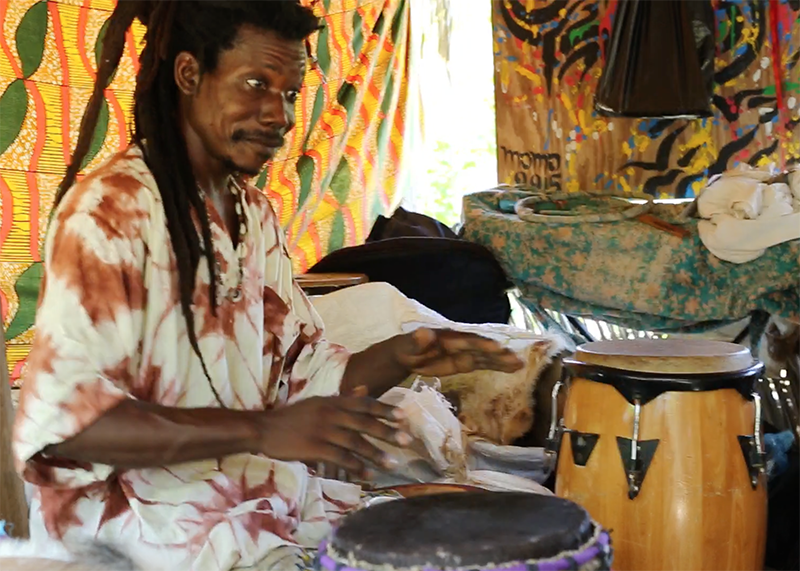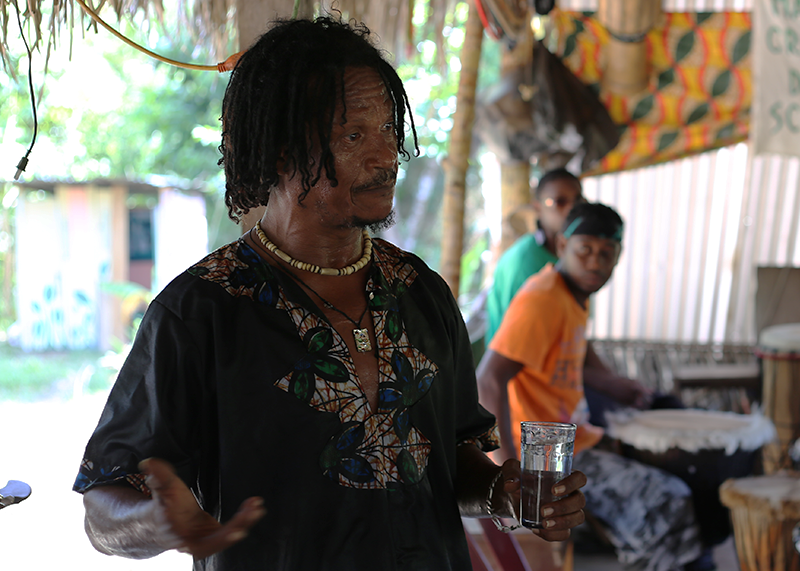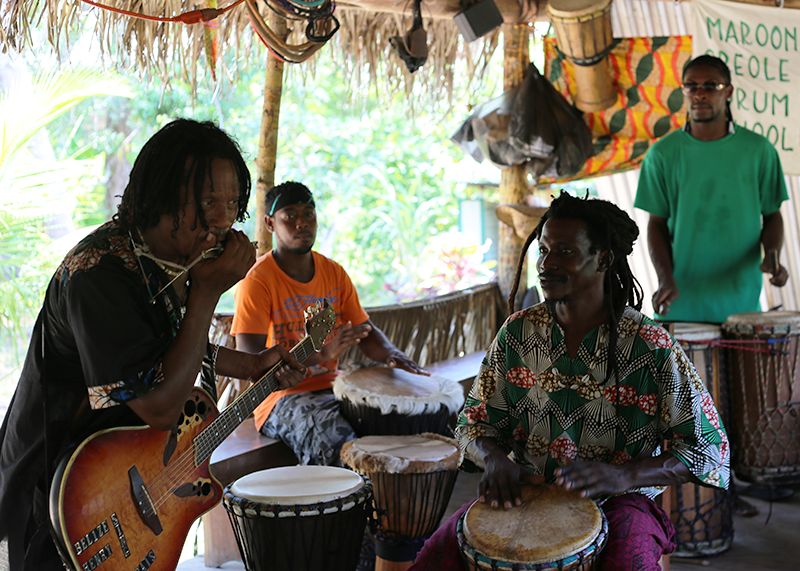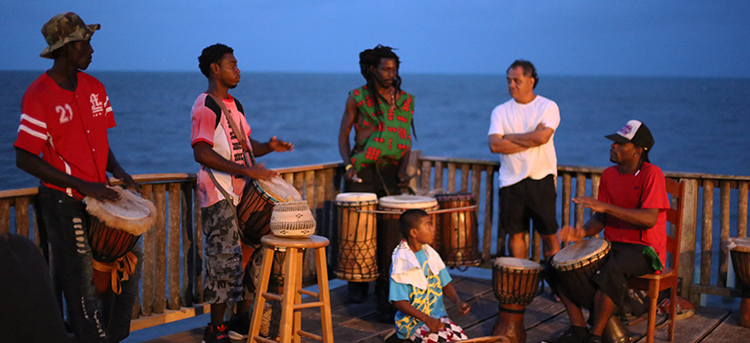Throw it out and change it up. Literally meaning “throw it long shore,” this expression is often called out during Sambai, a Creole music and dance tradition taking place around a fire during the full moon. Attendants of this fertility dance will chant “hibam lang sho” to call for a change in the music. As drum instructor of Maroon Creole Drum School, Emmeth Young explains, the phrase comes with a bit of ambiguity. Some may actually use it to cheer on the drummers—to show they enjoy the energy as it is. Seems very different from asking for a change of pace.
Or does it? The two conflicting definitions actually go hand in hand. If we do truly love the energy, why stop the momentum? Why stay comfortable? As much as I love my life in the states, I came to Belize for a new flavor. I thought my mind was quite open before but not nearly as open as it became after calling out “hibam lang sho” and beginning my experience in the Belizean melting pot.
Jamming out on djembes with talented drummers at Emmeth’s has taught me to relax, and I don’t just mean my hands. As we’ve played together, I would feel the need to change up the rhythm I was playing when it was never called for. Emmeth always gives me a smile and a shake of the head when I’m trying too hard, mouthing out the beat in control, “dun… dee dun dee dun… digga dun.”

Playing in a drum circle with brand new friends has demonstrated so much to me about communicating and being a part of my community. The spotlight will come, but not without first contributing to something greater than yourself or even the individuals around you—the collective sound. Even outside of the circles, you won’t sense anxiety from most Punta Gorda locals. They aren’t the least bit concerned about being in the spotlight or you being in the spotlight, while the average American won’t stop asking, “What’s next?” or “When do I get more?” The people here toss those anxieties to focus on something greater, knowing the lead will come their way when time says so. “Speak!” My fellow drummers repeated to me as I was lost in our rhythm—insisting I play a solo.
We all need to call “hibam lang sho” once and a while. How else will we develop? I know about a handful of crappy dance moves that I thoroughly enjoy botching, and I could continue life with just those and be perfectly happy. The experience of immersing yourself in a new environment whether it’s across the sea or across the street is the only way to grow. Even if I can’t easily mix the Sambai move I learned today into American culture, I shared an experience with a new culture, and that will never leave me even if I forget how to actually execute the move.
Emmeth has adapted the Creole tradition by mixing in junjuns and djembes for more flavor. This is one example of how he has freshened up Creole culture to make it more relevant in his community, so the traditions live. Customarily, the lead drummer kicks off Sambai with seven solemn eighth notes and a small group of drummers begins the rhythm, “dun digga dun digga dun digga dun digga.” The lead drum part passes around open to improvisation. The village circles wide around the fire shouting call-and-response chants. One calls everyone to join the Sambai. The leader shouts phrases (phonetically) like “Ay mama da machula” or “Ayyyy machula,” and all respond, “Sambai da machula!” Another, “Koko faiya!” “Hokeenahneebay!” “Here! Here!” “Hokeenahneebay!” taken literally means all the girls and guys are ready for sex. Others tell stories about what’s happening in the village; stories we can still relate to today like a mother neglecting her child or a girl getting pregnant.

One at a time, members of the village dance into the center of the circle to show off their stuff. Once they finish, they must choose someone to replace them, and of course you don’t always choose just anyone. If two people choose each other over and over again, you might just cause a stir in the community. And yes, there’s a chant for that, too. Officially, you choose a mate by the end of Sambai.
The first time I was called in, I tried out the Sambai move I was shown. Garbage. Hahaha. I was literally tripping all over the sand and falling into our faux fire. But the more I was called in, the more my feet began to accept. Jill, Emmeth’s wife who has done much to develop the school and the “Drums Not Guns” mission told me I was getting it by my last turn. To be honest, it still mostly felt like I was falling over. But in the end, it did feel good to fall.

We all should be able to change our mentality. It may not always be the easiest, but it is the most accessible option when faced with challenges. I can only do so much to stay cool in Belize. Go outside and the sweat pours no matter what. But what I can do is stop allowing it to bother me and toss those useless concerns to the shore. Put that energy toward caring about something that actually matters like engaging with human beings.
The next day, we met Henry III, front man of the Tala Wala Vibration project with Emmeth and others. He had a captivating stage presence and put on a show for us with his guitar and harmonica, encouraging us all to join in. Everyone was handed at least a glass pint bottle, fork, and of course could utilize their own pipes to contribute to some spectacular jam sessions. In between songs, he would talk and talk. Many of his lectures were very inspiring such as his speech on consuming only things from nature and not the “devil’s soup” (rum). He raised his glass of water high, explaining its significance, “You must not distance yourself from the world around you. This is what is important.”

But not all of his speeches were so significant. As Emmeth would tell me later, Henry gets very excited when he has an audience, since they are not easy to come by in Belize. He would ramble about his travels and rich ancestry of Creole, Italians, Maya, Scottish, and even hinted at more. During one of his stories, his point was completely lost, so Emmeth called to him, “Hibam lang sho.” But he wouldn’t wrap it up. “Hibam lang sho. Hibam lang sho. Hibam lang sho,” Emmeth said again and again and again rolling his eyes. Finally, Henry calmly shut his mouth and picked his guitar back up.

We all love to preserve our traditions, but what is more important is to move on. Henry told us as if he was the first to say, “It is sad, but all good things come to an end.” Keeping things fresh is always more valuable than struggling to isolate ourselves and preserve our stagnant cultures. On the contrary, culture dies when we fear change and can’t let it live—free to be shared with others.
Henry’s friends laugh at his ridiculousness, but he is a wise man because like most Belizeans, he understands the importance of changing it up. With his diversity and all the prosperous gifts of his land, he is rich. His words echoed those of Punta Gordian artist Dr. Ludwig V. Palacio.

I am RICH
by Dr. Ludwig V. Palacio
I am rich
with Vegetation,
Sunshine,
Trees,
Birds,
Caves,
Waterfalls,
and Mountains.
I am rich.
I have Creole,
Garifuna,
Maya,
Meztizo,
and East Indian.
I am rich.
I have a cool house from the green forest.
I have fresh Fruits,
Ground food and Vegetables,
Fish from the sea,
And good friends for everlasting.
I am rich, my dear,
for I am Belizean.
